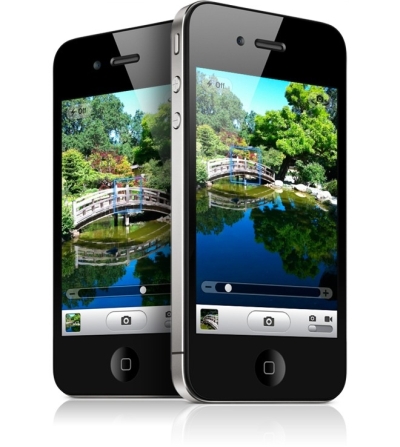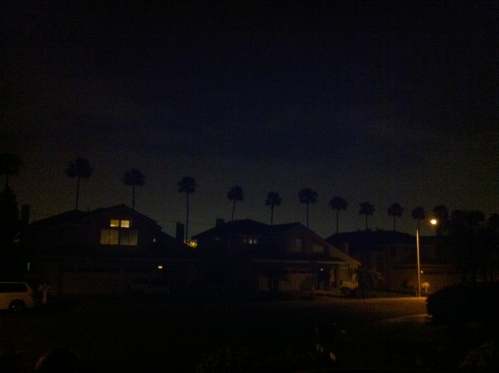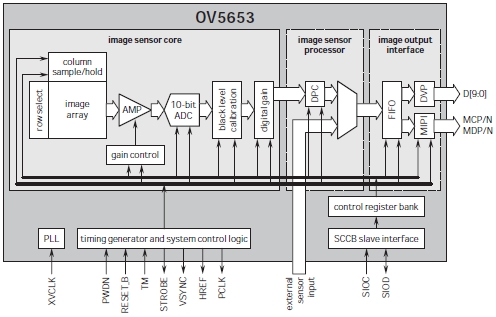Index
Front and Back Cameras - New CMOS Sensors
Since the introduction of the original iPhone in summer 2007, the iPhone 4's camera system has been by far one of the more significant overhauls that the platform experienced and has been a notable topic of discussion since WWDC 2010. The original iPhone launched with a fixed-focus lens and a contemptible 2 megapixel CMOS sensor that lacked the capacity to produce any meaningful low-light, motion or close-up shots worth keeping. After twelve months came and went, the iPhone 3G appeared on the scene with the exact same sensor and produced almost identical shots with very subtle lighting improvements. Another twelve months went by, and the iPhone 3GS launched with a 3 megapixel sensor, autofocus, and a "tap-to-focus" system to link the focus control and autoexposure system to a specific point in the image. As many came to notice, it was also the first iPhone sensor capable of shooting VGA-quality video clips, however very limited in resolution. Despite the improvements over this 2-year product cycle, many critics remained unimpressed with these hardware changes and desired a product with image quality more resemblant of an amateur, pocket sized point-and-shoot camera.

During his WWDC 2010 keynote, Steve Jobs said that getting great looking images wasn't just about increasing the camera's megapixels. It had more to do with grabbing more photons from the ambient environment. By increasing the photon count, more light gets let into the sensor, and images will look noticeably better. Let's take a look at the sensor differences between the iPhone 3GS and the iPhone 4.
The iPhone 3GS features a 3.1MP, 1/4" CMOS sensor from OmniVision. According to Apple, that sensor has 1.75µm pitch individual pixels. In contrast, the iPhone 4 features a 5MP, 1/3.2" CMOS sensor with backside illumination. By increasing the size of the sensor itself, the size of the individual pixels remains the same at 1.75µm pitch, but the backlit sensor has circuitry on the back of the chip, keeping it out of the way of light and effectively allowing more light to reach individual photo diodes in each pixel location.
During the weekend of iPhone 4 launch day, we attended a concert by one of our favorite bands in San Diego and attempted to capture our very first iPhone 4 snapshots using the new backside illuminated CMOS sensor. The results were quite impressive, the quick response time of the autofocus lens significantly enhances the value of capturing motion shots by improving shutter lag.

5 megapixel still shot (2592x1936) taken at Moonlight Beach in Encinitas, California. Full resolution here.

5 megapixel action shot with 5x Digital Zoom taken at Moonlight Beach in Encinitas, California. Full resolution here.

5 megapixel night shot taken in Cypress, California. Full resolution here.
The fact that Steve Jobs even mentioned the specifications of the new CMOS sensor during WWDC is a sign that Apple is taking the camera much more seriously with this generation. Based on the product brief published by OmniVision, "the OV5653 delivers the industry's best low-light sensitivity of >1300mV/(lux-sec) - a 40 percent improvement over previous FSI devices - and a 2x improvement in signal-to-noise ratio (<70lux)." ArsTechnica recently held an interview with Dr Eric Fossum, an expert in CMOS image sensor technology, about the importance of backside illumination for digital cameras. "Backside illumination was essentially devised for the mobile market—as sensors continued to shrink, something was needed to increase the sensitivity," said Dr Fossum. In addition, Chris Foreman from ArsTechnica dives into the specifics behind Apple's new CMOS sensor, why some pixels are more equal than others, and how the iPhone 4 offers a sizable amount of photo and video power for the average user.

(OmniVision OV5653 5MP 1/3.2" CMOS sensor with backside illumination)
The iPhone 4's backside camera also brings with it a new complementary LED-based flash on the right hand side. At the top left of the Camera app in iOS 4, there is a translucent button that allows a user to set the flash to Auto (default), On or Off. The controls work for both still shots and video, and is particularly useful for capturing night video. We've also found that the LED flash doubles as a reasonably bright flashlight almost equivalent to a typical Performance LED Pocket Flashlight, but with more light focused in a central location.
In terms of image clarity, the iPhone 4's front-facing camera captures still shots and video at a mediocre VGA resolution (640x480). We might also add that it's idealistically convenient for taking quick portrait snapshots either alone or with another person, although there is somewhat of a "fish eye" lens effect that gives an unrealistic facial perspective on pictures that are shot too close up.
As with the iPad, the iPhone 4 now offers support for 720p H.264 video playback and motion JPEG video playback. This is a huge leap over the maximum 640x480 playback resolution on the iPhone 3GS. Consequently, videos from the iTunes Store designated as "HD" will now play on the iPhone 4 as well as unconverted .AVI formatted M-JPEG HD videos made on a select list of cameras, including some recent Nikons. For some reason, however, MPEG-4 videos recorded at 1280x720 on other video cameras will not play on the iPhone 4 without a transcoding. Apple has also indicated that the iPhone 4 is compatible with the iPad Dock Connector to VGA adapter, currently the highest-resolution video output solution available for the iPhone 4 and the iPad. Unfortunately, the dock does not provide audio output and the video output resolution is capped at 1024x768, modestly below the 1280x720 playback capabilities of the iPhone 4.



